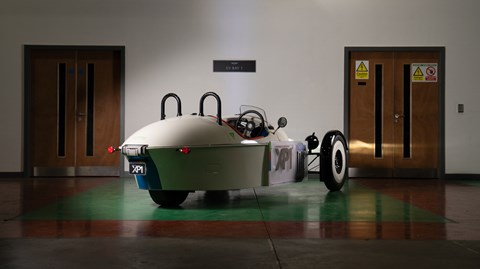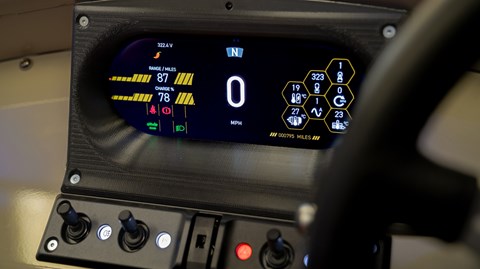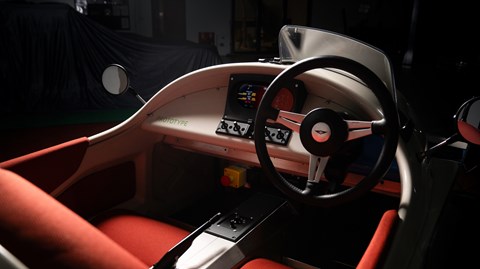► Electric three-wheeler revealed
► No confirmed on-sale date yet
► Same chassis as the usual Morgan
Is no tradition sacred? Morgan, previously the last remaining bastion of string-backed driving gloves, has built an electric three-wheeler case study, the XP1. Flat-capped moustaches will be bristling at the affrontery.
Although it’s only a prototype at this stage and has no confirmed on-sale date, this isn’t some vapourware concept car as it’s based around the same chassis and aluminium monocoque as the Ford-engined Super 3. Plus, the XP1 actually works – a prototype has been up and running for three months now.

EV deniers should be aware it weighs less than 700kg, despite carrying a 33kWh battery under the bonnet (roughly the same size as the Mini Electric’s). That’s only about 60kg more than the ICE version of the 3, which should help keep the doubters at bay.

It’s no surprise that the company has been so rigid on what it feels is a key aspect of a Morgan, whether it’s electric or not. Matt Hole, Morgan’s CTO, told us that ‘Morgan is so unique. We had to keep it lightweight – we’ve borrowed the bits we need and then integrated them within the 3. Just like we’re integrators in our ICE cars, so we will become integrators in EVs.’ By picking and choosing parts that fit its strict brief of keeping the weight as low as possible, the firm can combine them with a Morgan twist to create the eccentric cars it’s known for.

To that end, the electrical gubbins comes from various companies. The 100kW motor from UK firm iNetic is mounted in the transmission tunnel and still powers the single rear wheel, while the inverter is from a Chinese OEM. There are four power levels on the car, indicated by the number of chilis showing on the dash, and unlike on some EVs, the noise from the electrical motor is completely natural. There’s no synthesised sound, which is doubly handy because the XP1 doesn’t have any speakers to pump it through.
Suspension development work is ongoing as Morgan continues to experiment with what feels correct. As Hole points out, ‘we’ve tried to make it engaging. There aren’t any gears, so we’ve tried to make it drive in such a way that it [the XP1] tunes your brain to do other things as you’re driving along. It needs character.’

As it stands, the spring rates and front dampers have been tweaked to cope with the extra weight from the batteries. The additional heft has also meant the steering geometry has been changed, to give the car more bite when turning into a corner and because there’s more urgency to the torque delivery in an electric car.
That additional torque is also why Morgan hasn’t yet settled on a rear tyre configuration for the XP1. The unusual front tyres remain the same as the Super 3 (they’re such a unique design it’s difficult to change them), but the rear’s spec is still up for debate.

The bodywork remains largely the same as the Super 3 – it’s identical behind the rear hoops – but changes to the front, underfloor and fitting of wheel spats means the drag coefficient has dropped by a third, from 0.65 to 0.42Cd.
Modelled with CFD, the XP1 has unique side blades with asymmetric holes carved into them to better deflect air along the sides of the car. A completely flat underfloor helps reduce drag, while the ICE car’s vents on the leading edge of the bonnet are filled in by LEDs that light up to show when the car is charging.

It’s unlikely the prismatic battery arrangement would see production (Hole favours a cylindrical set-up) and in an ideal world the motor would move back from the transmission tunnel, be rotated through 90 degrees and then placed into the space where the bevel box normally sits. It would save on gearing costs and be a far more efficient way to manufacture the car.
Thanks to Morgan’s new toolchain development software – used on the XP1 and also rolled out across all its upcoming cars – Hole knows this is a solution that works. But budgets being what they are, the XP1 prototype is stuck with the cheaper solution of the motor in the transmission tunnel, certainly during this development phase.

Although it’s yet to be confirmed for production, the XP1 is vital for Morgan as electrification becomes ever more dominant. Currently, the Wiltshire firm uses a mix of Ford and BMW engines, but as those manufacturers commit to a far more electrified future, their powertrains will become increasingly rare commodities. ‘This gives us a future opportunity for our powertrain changing,’ according to Hole.
Given the time and effort that Morgan has expended on the XP1 and the way that the wind is blowing in general, you’d be a brave person to bet against it appearing in production form before too long.